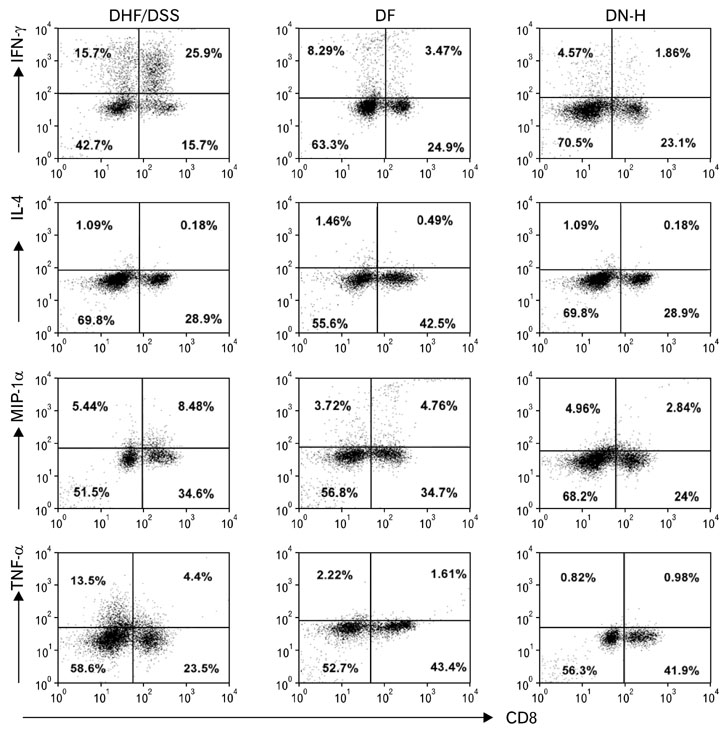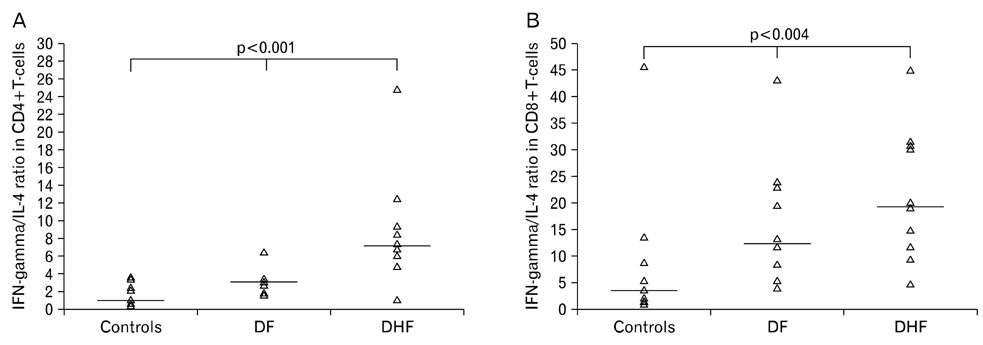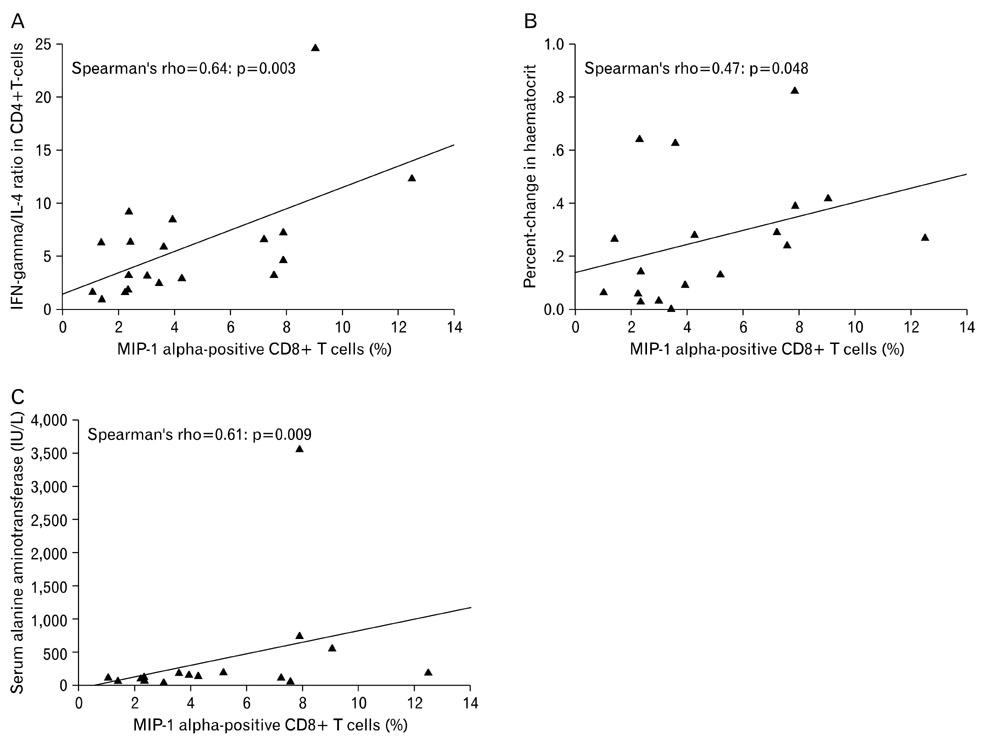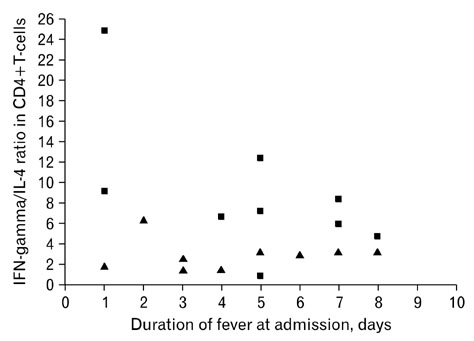Immune Netw.
2010 Oct;10(5):164-172. 10.4110/in.2010.10.5.164.
Association of Intracellular T(H)1-T(H)2 Balance in CD4+ T-cells and MIP-1alpha in CD8+ T-cells with Disease Severity in Adults with Dengue
- Affiliations
-
- 1Department of Medicine, All India Institute of Medical Sciences, New Delhi, India. sksharma@aiims.ac.in
- 2Department of Transplant Immunology and Immunogenetics, All India Institute of Medical Sciences, New Delhi, India. salilmitra1@yahoo.com
- 3Department of Microbiology, All India Institute of Medical Sciences, New Delhi, India.
- KMID: 1456220
- DOI: http://doi.org/10.4110/in.2010.10.5.164
Abstract
- BACKGROUND
We tested the hypothesis that dengue haemorrhagic fever (DHF) is associated with a T(H)1-skewed immune response as opposed to dengue fever (DF).
METHODS
We estimated intracellular (in T-cells) and serum levels of designate T(H)1/T(H)2 cytokines [interferon-gamma (IFN-gamma), interleukin-4 (IL-4), and tumor necrosis factor-alpha] and macrophage inflammatory protein-1alpha (MIP-1alpha) at admission, 48 h, and day 5 in 20 adults with dengue (DF=10, DHF=10) and 10 dengue-naive healthy controls.
RESULTS
At admission, intracellular IFN-gamma/IL-4 ratio in CD4+ T-cells and proportion of MIP-1alpha-positive CD8+ T-cells were significantly higher in patients with DHF [7.21 (5.36~10.81) vs. 3.04 (1.75~4.02); p=0.011 and 6.2% (3.2~8.2%) vs. 2.4% (2.0~3.6%); p=0.023]. The latter showed a significant positive correlation with IFN-gamma/IL-4 ratio in CD4+ T-cells (Spearman's rho=0.64; p=0.003), percentage-change in haematocrit (rho=0.47; p=0.048), and serum alanine aminotransferase level (rho=0.61; p=0.009).
CONCLUSION
We conclude that DHF is associated with a T(H)1-skewed immune response. Further, MIP-1alpha in CD8+ T-cells is an important immunologic correlate of disease severity in dengue.
Keyword
MeSH Terms
Figure
Reference
-
1. Rigau-Pérez JG, Clark GG, Gubler DJ, Reiter P, Sanders EJ, Vorndam AV. Dengue and dengue haemorrhagic fever. Lancet. 1998. 352:971–977.
Article2. Burke DS, Nisalak A, Johnson DE, Scott RM. A prospective study of dengue infections in Bangkok. Am J Trop Med Hyg. 1988. 38:172–180.
Article3. Green S, Rothman A. Immunopathological mechanisms in dengue and dengue hemorrhagic fever. Curr Opin Infect Dis. 2006. 19:429–436.
Article4. Libraty DH, Endy TP, Houng HS, Green S, Kalayanarooj S, Suntayakorn S, Chansiriwongs W, Vaughn DW, Nisalak A, Ennis FA, Rothman AL. Differing influences of virus burden and immune activation on disease severity in secondary dengue-3 virus infections. J Infect Dis. 2002. 185:1213–1221.
Article5. Green S, Vaughn DW, Kalayanarooj S, Nimmannitya S, Suntayakorn S, Nisalak A, Lew R, Innis BL, Kurane I, Rothman AL, Ennis FA. Early immune activation in acute dengue illness is related to development of plasma leakage and disease severity. J Infect Dis. 1999. 179:755–762.
Article6. Spain-Santana TA, Marglin S, Ennis FA, Rothman AL. MIP-1 alpha and MIP-1 beta induction by dengue virus. J Med Virol. 2001. 65:324–330.7. Mabalirajan U, Kadhiravan T, Sharma SK, Banga A, Ghosh B. Th(2) immune response in patients with dengue during defervescence: preliminary evidence. Am J Trop Med Hyg. 2005. 72:783–785.
Article8. Dengue/dengue haemorrhagic fever - Dengue cases and deaths since 2001. National Vector Borne Disease Control Programme, Directorate General of Health Services, Ministry of Health and Family Welfare, Government of India. Accessed 17 June, 2009. Available at URL: http://www.nvbdcp.gov.in/dengueC&D.html.9. Deen JL, Harris E, Wills B, Balmaseda A, Hammond SN, Rocha C, Dung NM, Hung NT, Hien TT, Farrar JJ. The WHO dengue classification and case definitions: time for a reassessment. Lancet. 2006. 368:170–173.
Article10. World Health Organization (WHO). Dengue hemorrhagic fever: diagnosis, treatment, prevention and control. 1997. 2nd Edn. Geneva: WHO;12–23.11. Bharaj P, Chahar HS, Pandey A, Diddi K, Dar L, Guleria R, Kabra SK, Broor S. Concurrent infections by all four dengue virus serotypes during an outbreak of dengue in 2006 in Delhi, India. Virol J. 2008. 5:1.
Article12. Kuo CH, Tai DI, Chang-Chien CS, Lan CK, Chiou SS, Liaw YF. Liver biochemical tests and dengue fever. Am J Trop Med Hyg. 1992. 47:265–270.
Article13. Cook DN, Beck MA, Coffman TM, Kirby SL, Sheridan JF, Pragnell IB, Smithies O. Requirement of MIP-1 alpha for an inflammatory response to viral infection. Science. 1995. 269:1583–1585.
Article14. Murgue B, Cassar O, Deparis X, Guigon M, Chungue E. Implication of macrophage inflammatory protein-1alpha in the inhibition of human haematopoietic progenitor growth by dengue virus. J Gen Virol. 1998. 79:1889–1893.
Article15. Halstead SB. Pathogenesis of dengue: challenges to molecular biology. Science. 1988. 239:476–481.
Article16. Kontny U, Kurane I, Ennis FA. Gamma interferon augments Fc gamma receptor-mediated dengue virus infection of human monocytic cells. J Virol. 1988. 62:3928–3933.
Article17. Schroder K, Hertzog PJ, Ravasi T, Hume DA. Interferon-gamma: an overview of signals, mechanisms and functions. J Leukoc Biol. 2004. 75:163–189.18. Bukowski JF, Kurane I, Lai CJ, Bray M, Falgout B, Ennis FA. Dengue virus-specific cross-reactive CD8+ human cytotoxic T lymphocytes. J Virol. 1989. 63:5086–5091.
Article19. Loke H, Bethell DB, Phuong CX, Dung M, Schneider J, White NJ, Day NP, Farrar J, Hill AV. Strong HLA class I--restricted T cell responses in dengue hemorrhagic fever: a double-edged sword? J Infect Dis. 2001. 184:1369–1373.
Article20. Cook DN, Smithies O, Strieter RM, Frelinger JA, Serody JS. CD8+ T cells are a biologically relevant source of macrophage inflammatory protein-1 alpha in vivo. J Immunol. 1999. 162:5423–5428.21. Karpus WJ, Lukacs NW, Kennedy KJ, Smith WS, Hurst SD, Barrett TA. Differential CC chemokine-induced enhancement of T helper cell cytokine production. J Immunol. 1997. 158:4129–4136.22. Chaturvedi UC, Agarwal R, Elbishbishi EA, Mustafa AS. Cytokine cascade in dengue hemorrhagic fever: implications for pathogenesis. FEMS Immunol Med Microbiol. 2000. 28:183–188.
Article23. Chen RF, Liu JW, Yeh WT, Wang L, Chang JC, Yu HR, Cheng JT, Yang KD. Altered T helper 1 reaction but not increase of virus load in patients with dengue hemorrhagic fever. FEMS Immunol Med Microbiol. 2005. 44:43–50.
Article24. Chaturvedi UC, Raghupathy R, Pacsa AS, Elbishbishi EA, Agarwal R, Nagar R, Misra A, Kapoor S, Mathur A, Khan MAY, Azizieh F. Shift from a Th1-type response to Th2-type in dengue haemorrhagic fever. Curr Sci. 1999. 76:63–69.25. Chareonsook O, Foy HM, Teeraratkul A, Silarug N. Changing epidemiology of dengue hemorrhagic fever in Thailand. Epidemiol Infect. 1999. 122:161–166.
Article26. Nguyen TH, Nguyen TL, Lei HY, Lin YS, Le BL, Huang KJ, Lin CF, Do QH, Vu TQ, Lam TM, Yeh TM, Huang JH, Liu CC, Halstead SB. Association between sex, nutritional status, severity of dengue hemorrhagic fever, and immune status in infants with dengue hemorrhagic fever. Am J Trop Med Hyg. 2005. 72:370–374.
Article27. Rodríguez L, González C, Flores L, Jiménez-Zamudio L, Graniel J, Ortiz R. Assessment by flow cytometry of cytokine production in malnourished children. Clin Diagn Lab Immunol. 2005. 12:502–507.
Article28. Lühn K, Simmons CP, Moran E, Dung NT, Chau TN, Quyen NT, Thao le TT, Van Ngoc T, Dung NM, Wills B, Farrar J, McMichael AJ, Dong T, Rowland-Jones S. Increased frequencies of CD4+ CD25(high) regulatory T cells in acute dengue infection. J Exp Med. 2007. 204:979–985.
- Full Text Links
- Actions
-
Cited
- CITED
-
- Close
- Share
- Similar articles
-
- Association of Intracellular T(H)1-T(H)2 Balance in CD4+ T-cells and MIP-1alpha in CD8+ T-cells with Disease Severity in Adults with Dengue
- Role for CD40 and CD40L Expression in Generating CD8 T Cell Response to Minor Histcompatibility Antigen, H60
- Distinct Humoral and Cellular Immunity Induced by Alternating Prime-boost Vaccination Using Plasmid DNA and Live Viral Vector Vaccines Expressing the E Protein of Dengue Virus Type 2
- The Role of CD4 T Cell Help in CD8 T Cell Differentiation and Function During Chronic Infection and Cancer
- Expression of MIP-1alpha mRNA in Kupffer Cells and Serum MIP-1alpha Post Portal Vein Transfusion





